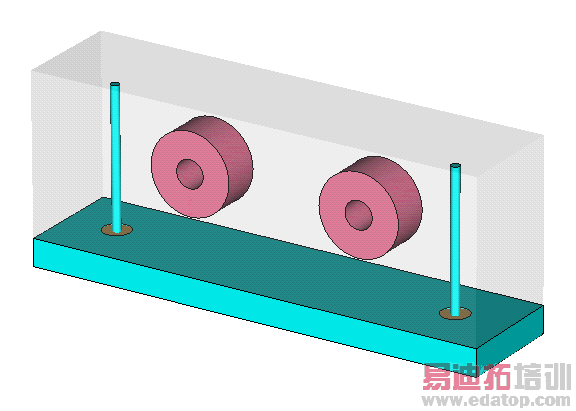- 易迪拓培训,专注于微波、射频、天线设计工程师的培养
Dielectric Resonator Filter Design - CST2013 MWS Examples
|
General Purpose Hexahedral: |
|
|
General Purpose Tetrahedral: |
|
|
Fast Resonant Hexahedral: |
|
|
Fast Resonant Tetrahedral: |

General Description
This filter is build up by a metallic box, including two cylindrical, dielectric insertions. Elongated inner conductors of two coaxial lines are the input and the output of the structure. The two dielectric discs act as coupled resonators such that the entire device becomes a high quality band pass filter.
The same structure has also been simulated with the Time Domain solver.
Structure Generation
The most important parts of the structure are modelled by cylinders. The coaxial lines as well as the dielectric discs are of cylindrical shape. Only the metallic ground plane where the coaxial ports are located and the surrounding space are bricks. For the real world structure there is a metallic box that encloses the structure. For the simulation, this box is omitted, because it can be simulated by electric boundary conditions.
Tetrahedral Mesh Settings (General Purpose Solver, Fast Resonant Solver)
With both the coaxial feeds and the dielectric rings, the most important parts of the filter are curved. Thus, the "curved element order" has been set to Two in the special tetrahedral mesh properties.
Hexahedral Mesh Settings (General Purpose Solver)
The mesh type was set to "Hexahedral Mesh" in the frequency domain solver dialog. Additionally, both the number of lines per wavelength and the lower mesh limit are increased to 15.
Solver Setup
Because of the symmetry of the structure a magnetic symmetry condition is used (Only one half of the structure needs to be simulated to obtain the results of the entire structure).
This example is simulated using both general purpose frequency domain solvers (hexahedral and tetrahedral.) The broadband frequency sweep is enabled, with as many frequency samples in the range from 4.5 GHz to 4.6 GHz as required. Both general purpose solvers reach the scattering parameter convergence threshold (0.01 as a default, checked twice) after calculating less than ten frequency samples. The progression of the scattering parameter sweep error measure is shown in the 1D Results  Convergence
Convergence  S-Parameter folder.
S-Parameter folder.
Please note that the general purpose solvers become increasingly faster in subsequent runs, which is due to an improved initial solution.
In addition, the S-parameters for this example are simulated using the "Resonant: Fast S-parameter" solvers with hexahedral and tetrahedral mesh.
Post Processing
The scattering parameters can be accessed through the 1D Results folder in the navigation tree. The results of the different frequency domain S-parameter calculations can be compared to each other as well as to the time domain simulation by copying the signals into a user defined tree folder (for more information have a look at the topic "1D Result View" in the MWS online help).
CST微波工作室培训课程套装,专家讲解,视频教学,帮助您快速学习掌握CST设计应用
上一篇: Antenna Placement - CST2013 MWS Examples
下一篇: Antenna on thin substrate using local multilayer in presence of fra
 最全面、最专业的CST微波工作室视频培训课程,可以帮助您从零开始,全面系统学习CST的设计应用【More..】
最全面、最专业的CST微波工作室视频培训课程,可以帮助您从零开始,全面系统学习CST的设计应用【More..】
频道总排行
- Rectangular Waveguide Tutorial
- FSS: Simulation of Resonator
- CST2013 MWS Examples: Thermal C
- Dipole Antenna Array - CST201
- CST MWS Examples - CST2013 M
- Microstrip Radial Stub - CST2
- Dielectric Resonator Antenna -
- Interdigital Capacitor - CST20
- CST2013 MWS Examples: Biological
- Lossy Loaded Waveguide - CST2
